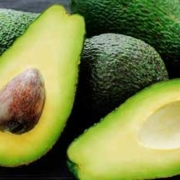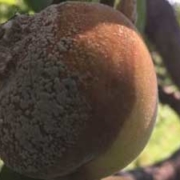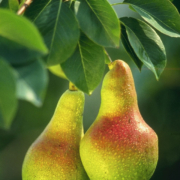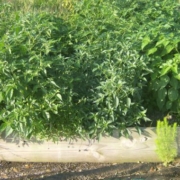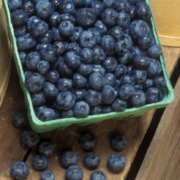Avocados: Fruit Set Challenges and Propagation
 Print This Post
Print This Post
By Omar Rodriguez, NCAT Agriculture Specialist
Having decided to settle down in a suburb, my parents had limited space to grow all of the plants that they wanted. One thing was for certain: avocados would be a part of the mix. Starting with one tree in the back yard, yields were lacking and we couldn’t figure out why. Was it the water? Was nutrition responsible? Like all plants, avocados have secrets to share; understanding the plants we grow can unlock their potential and bring a deeper understanding of the ecology in our own back yards. Below are some considerations for your backyard avocados, as well as a propagation technique that can be used on a number of plants.
Do you have an avocado tree that doesn’t seem to ever set very much fruit even when its flowers are plentiful? The avocado plant has a unique trait that may help to explain the challenge. It has to do with its flowers and the timing of its sexual organs.
The first thing that should be understood about the avocado flower is that it is bisexual or perfect, meaning that each flower contains both male and female organs. This trait is exhibited by many plants, but what makes the avocado different is that the male portion of the flower will release pollen during a specific time of day while the female portion will be receptive at another time. This trait will be present whether you have one tree or a group of the same cultivar or type (more information on types below). That is to say, if you had an orchard or a backyard full of Hass avocados (A-type), the male and female organs will follow the same alternating schedule and cross-pollination will be limited as a result.
Another common reason for low fruit set is lack of pollinators, native or otherwise. This can be easily resolved with the addition of native habitat, a beehive…or both.
How might one resolve this little timing conundrum? Plant another avocado tree that has opposing timing: organs (pistils) of one type are receptive when the male part (stamen) of another type is releasing pollen. Avocado cultivars belong to one of two types (A and B). By selecting opposite types, voila, you will be swimming in avocados, barring any unforeseen disasters or alternate limiting factors. Given how sensitive the avocado tends to be, you might also consider singing to it (up-tempo jazzy tunes are best) and applying only the finest of imported bottled water.
Here is an example of some of the more common avocado cultivars and their corresponding flower types:
- A-type cultivars: Hass, Anaheim, Pinkerton, Gwen, Reed, Lamb Hass
- B-type cultivars: Bacon, Whitsell, Zutano, SirPrize, Fuerte
Propagating Avocado from Cuttings
The propagation technique discussed in this blog can be used on many different species, though there will be some added context specific to avocados.
Propagation by stem cuttings is a common method for propagating woody plants. Cuttings of many favorite shrubs are quite easy to root. Whether you would like to propagate roses or rosemary, this method works for a variety of plants. Typically, stem cuttings of tree species are more difficult to root but can be accomplished with a bit of extra care and experimentation.
One of the primary reasons for cloning avocados is that they do not develop true to seed: An avocado grown from seed will not be the same as the parent it came from.
I should emphasize that propagation from cuttings is not a recommended practice for commercial operations where speed to maturity, and tolerance to a wider variety of diseases and soil conditions, are desired. In commercial avocado operations, the preferred practice is to graft rootstocks of more hardy cultivars (like some of the Mexican or West Indian options) with the scion of a tree that produces fruit with desirable characteristics. Propagation directly from cuttings takes out the additional step of grafting the scion to a rootstock; instead, you are cloning the tree with desired fruit and flowering behavior while promoting root growth of the same cultivar.
If the scion/rootstock method is preferred, check out this article for an extensive look at grafting techniques for avocados.
In either case, it is easier to simply purchase small trees at your local nursery; but where’s the fun in that? The process of grafting and rooting will lend a more intimate knowledge of the life cycle and anatomy of any plant you desire to propagate.
To get started you will need:
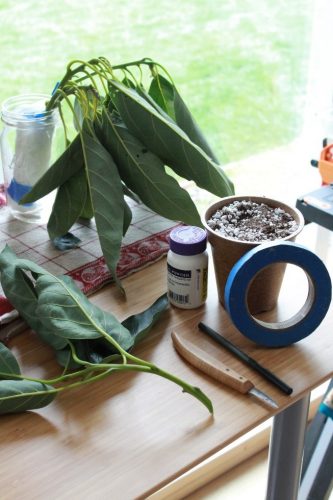
-Sharp knife or pruning shears: a clean knife will reduce the spread of pathogens between plants and increase your chances of success. Ethanol or isopropyl alcohol will do the trick.
-Tape/popsicle stick and pen: used to record the species and date of propagation. This step is particularly important if multiple cultivars are being propagated.
-Pots/trays and planting media: a 50/50 mix of perlite and peat moss generally yields good results.
-Rooting Hormone: Can be purchased or made at home. Store-bought options will include one of two active ingredients (Indole butyric acid or naphthalene acetic acid). There are many alternative options that can be made at home, and two of the more common techniques include honey water or tea made from the growing tips of willow branches.
-Access to the desired plant. Since this form of propagation creates a clone of the selected plant, it is important to select a healthy plant with good fruit set, along with any other desired characteristics.
Steps to propagation by cutting
-Remove a 6-inch section from of the end of a new shoot with a diagonal cut.
Note: The majority of plants propagated in this manner are most successful when succulent growth from the current season is used.
-Remove all of the fully developed leaves.
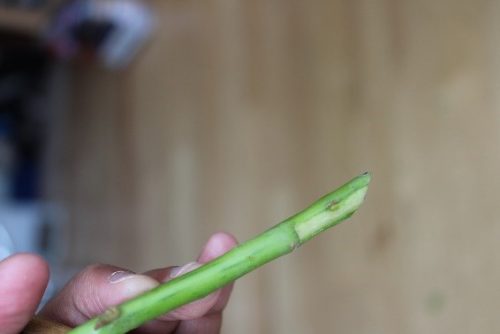
-Carefully cut away the thin bark to expose ½ inch of the cambium layer at the base of the cutting (see photo).
-Dip the exposed cambium at the base of your cutting into your preferred rooting solution.
-Insert the cutting into your moistened planting medium. If planting multiple cuttings into trays, provide sufficient spacing between plants (2-inch spacing between cuttings and rows will suffice).
-Cover the trays or pots with plastic bags to maintain humidity and keep indoors in an area that receives indirect sunlight whenever possible.
-After roughly three weeks, you can give the cutting a slight tug. If there is resistance, the avocado is producing roots.
-Transplant to a larger pot or directly outdoors (if the climate allows) in another three weeks.
Best of luck to all of you gardeners and farmers out there. I hope that your avocados produce a sharable bounty; your neighbors will thank you (on second thought, maybe better not to share, as neighbors may develop into full-blown pests). There’s nothing quite like a homegrown avocado.
This blog is produced by the National Center for Appropriate Technology through the ATTRA Sustainable Agriculture program, under a cooperative agreement with USDA Rural Development. ATTRA.NCAT.ORG.

